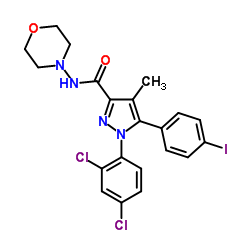AM281

AM281 structure
|
Common Name | AM281 | ||
|---|---|---|---|---|
| CAS Number | 202463-68-1 | Molecular Weight | 557.212 | |
| Density | 1.7±0.1 g/cm3 | Boiling Point | N/A | |
| Molecular Formula | C21H19Cl2IN4O2 | Melting Point | N/A | |
| MSDS | Chinese USA | Flash Point | N/A | |
| Symbol |

GHS06 |
Signal Word | Danger | |
|
Cannabinoid agonists rearrange synaptic vesicles at excitatory synapses and depress motoneuron activity in vivo.
Neuropharmacology 92 , 69-79, (2015) Impairment of motor skills is one of the most common acute adverse effects of cannabis. Related studies have focused mainly on psychomotor alterations, and little is known about the direct impact of cannabinoids (CBs) on motoneuron physiology. As key modulato... |
|
|
Activation of CB2 receptor is required for the therapeutic effect of ABHD6 inhibition in experimental autoimmune encephalomyelitis.
Neuropharmacology 99 , 196-209, (2015) Alpha/beta-hydrolase domain 6 (ABHD6) is a novel 2-arachidonoylglycerol (2-AG) hydrolytic enzyme, that can fine-tune the endocannabinoid signaling in the central nervous system. Recently we and others have demonstrated the protective effect of ABHD6 inhibitio... |
|
|
Cannabinoid receptor 1 inhibition improves the intestinal microcirculation in experimental endotoxemia.
Clin. Hemorheol. Microcirc. 58(2) , 333-42, (2014) Impairment of the intestinal microcirculation in endotoxemia may cause a deterioration of the mucosal barrier function thus releasing intraluminal bacteria and their toxins into the systemic circulation. In clinical sepsis this mechanism may influence disease... |
|
|
Cannabinoid-induced actomyosin contractility shapes neuronal morphology and growth.
Elife 3 , e03159, (2014) Endocannabinoids are recently recognized regulators of brain development, but molecular effectors downstream of type-1 cannabinoid receptor (CB1R)-activation remain incompletely understood. We report atypical coupling of neuronal CB1Rs, after activation by en... |
|
|
Ligand activation of cannabinoid receptors attenuates hypertrophy of neonatal rat cardiomyocytes.
J. Cardiovasc. Pharmacol. 64(5) , 420-30, (2014) : Endocannabinoids are bioactive amides, esters, and ethers of long-chain polyunsaturated fatty acids. Evidence suggests that activation of the endocannabinoid pathway offers cardioprotection against myocardial ischemia, arrhythmias, and endothelial dysfuncti... |
|
|
The fatty acid amide hydrolase inhibitor PF-3845 promotes neuronal survival, attenuates inflammation and improves functional recovery in mice with traumatic brain injury.
Neuropharmacology 85 , 427-39, (2014) Traumatic brain injury (TBI) is the leading cause of death in young adults in the United States, but there is still no effective agent for treatment. N-arachidonoylethanolamine (anandamide, AEA) is a major endocannabinoid in the brain. Its increase after brai... |
|
|
JZL184 is anti-hyperalgesic in a murine model of cisplatin-induced peripheral neuropathy.
Pharmacol. Res. 90 , 67-75, (2014) Cisplatin has been used effectively to treat a variety of cancers but its use is limited by the development of painful peripheral neuropathy. Because the endocannabinoid 2-arachidonoyl-sn-glycerol (2-AG) is anti-hyperalgesic in several preclinical models of c... |
|
|
Effects of cannabinoids on caffeine contractures in slow and fast skeletal muscle fibers of the frog.
J. Membr. Biol. 229 , 91-9, (2009) The effect of cannabinoids on caffeine contractures was investigated in slow and fast skeletal muscle fibers using isometric tension recording. In slow muscle fibers, WIN 55,212-2 (10 and 5 microM) caused a decrease in tension. These doses reduced maximum ten... |
|
|
Neuroprotective effects of the synthetic cannabinoid HU-210 in primary cortical neurons are mediated by phosphatidylinositol 3-kinase/AKT signaling.
Mol. Cell. Neurosci. 28 , 189-194, (2005) Cannabinoids (CBs) are neuroprotective in vivo and in vitro, but the mechanisms of their actions are unknown. The aim of this study was to elucidate the signaling pathways that mediate the protective effect of CBs on primary cultured neurons. The neurotoxin S... |
|
|
Effect of the cannabinoid receptor SPECT agent, AM 281, on hippocampal acetylcholine release from rat brain slices.
Neurosci. Lett. 238 , 84-86, (1997) The SPECT ligand AM 281, a less lipophilic analog of the cannabinoid receptor antagonist SR 141716A, robustly potentiated electrically-evoked release of acetylcholine from superfused hippocampal slices and prevented the inhibition of acetylcholine release by ... |